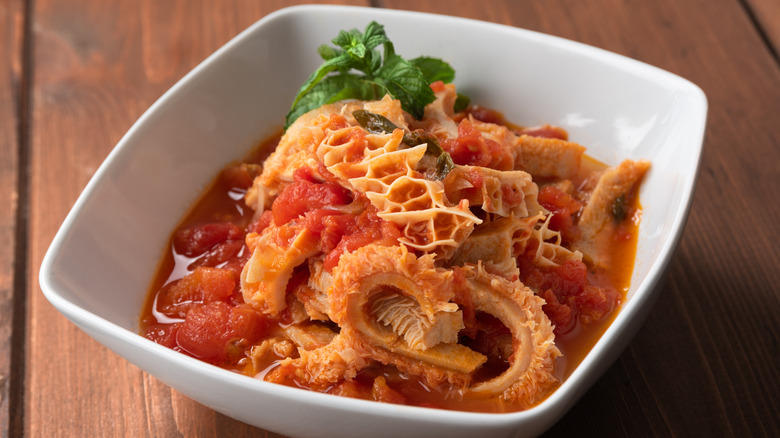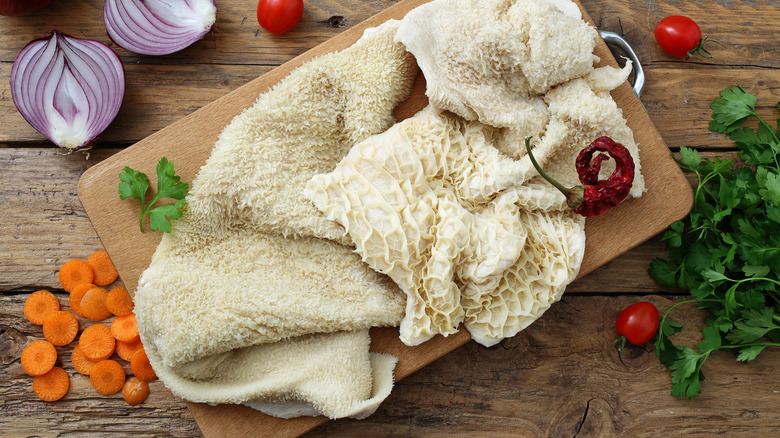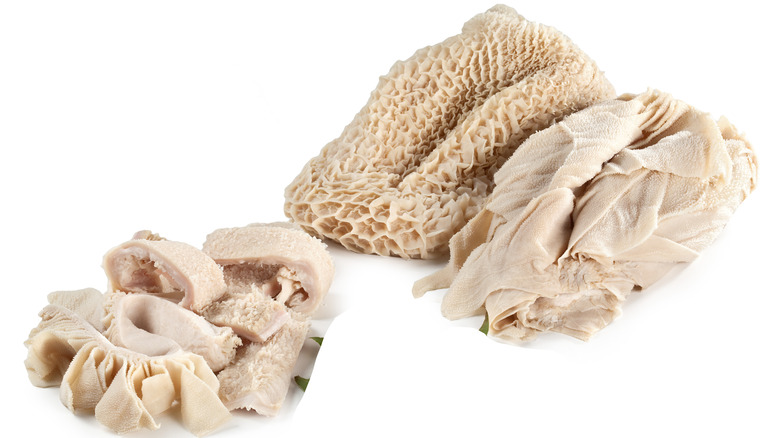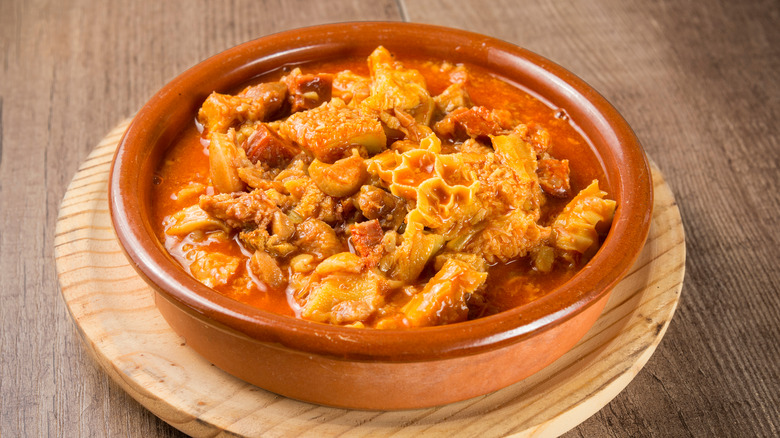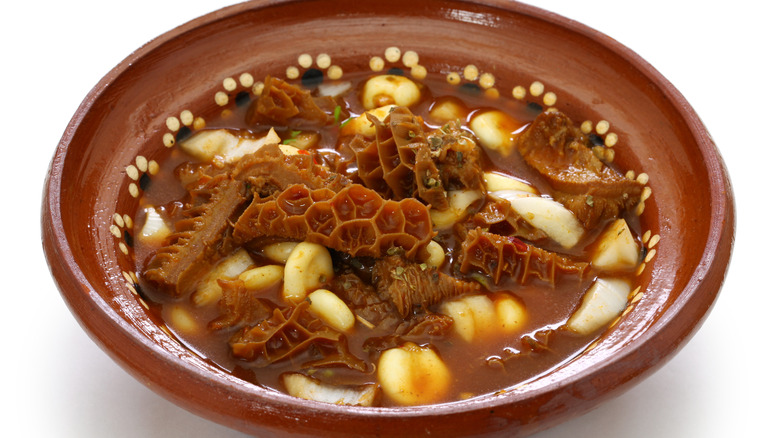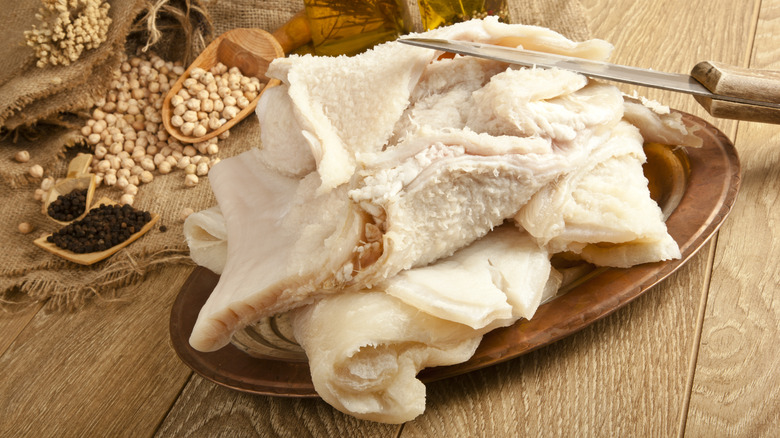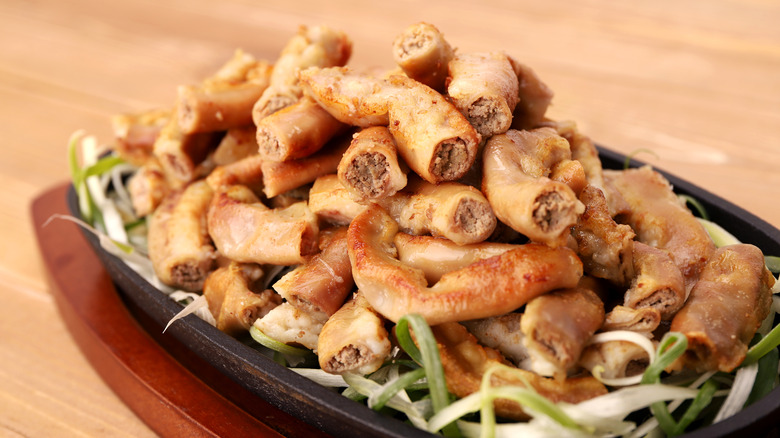What Is Tripe And Is It Good For You?
When dining at a restaurant with pals — or, worse, on a first date — the word "tripe" can trip you up. What's that one, again? You've definitely heard the word before, but is it a variety of asparagus, or an obscure organ from an unexpected animal? Throwing caution to the wind, you order the stewed tripe with confidence and authority, ignoring the alarmed look in your date's eyes and choosing instead to focus on your server's impressed nods as he writes it down. What have you just done?
Don't despair; you're not alone. Tripe might not exactly be the first thing that comes to mind when the general public thinks of meat, but it's becoming more common on menus and in supermarkets, and there are plenty of good reasons to try(pe) it. The guide below will tell you all about the mysterious dish you just ordered, and believe us when we say you're in for a real trip. Er, tripe.
What is tripe?
Essentially, tripe is stomach lining. According to Eater, tripe falls under the category of "offal," a name for the organs of an animal that we humans tend to overlook in the kitchen. (Yes, offal admittedly resembles the word "awful," but we're going to chalk that up to unfortunate coincidence.) Also called "variety meats," they're things like kidneys, hearts, and tongues — organs that are consumed, revered, or completely discarded in carnivorous cultures, depending on who you talk to. Tripe specifically refers to the stomach lining of ruminants, or animals with multi-chambered stomachs; think cows, goats, sheep, and even giraffes (via Encyclopedia Britannica).
Because there are many types of ruminant mammals — and many stomachs within each of them — tripe can be further broken down into four categories: blanket (or "flat"), honeycomb, book (or "bible"), and reed tripe, which come from the first, second, third, and fourth chambers of the stomach, respectively (via Healthline). For our purposes, we'll focus on honeycomb tripe — the one that comes from the second chamber of a mammal's stomach — because it's the one most commonly found in recipes, on menus, and, increasingly, in your local grocery store.
How is tripe made?
How is tripe made? It's actually a bit more complicated than it seems. The truth is that it's not enough to just get ahold of some stomach lining from a cow; tripe has to be "dressed" before it can be used for anything other than grossing out your friends (via The Spruce Eats). Undressed tripe tends to have a brown-y/green color, which is about as unappealing as the stench that accompanies it — hungry yet? So, to make things more palatable, you're going to want to bleach and boil that sucker.
As The New York Times points out, tripe is going to be bleached and treated by the time it reaches your supermarket shelf. This is why that instead of a brownish green blob, you will probably see two clean, white flaps, with a raised pattern that sort of resembles those paper honeycomb-shaped spheres often hung from the ceiling at parties, hence the name "honeycomb tripe." A butcher will have already processed the tripe, blanching and bleaching it to remove any impurities and give it a gleaning white sheen.
What does tripe taste like?
Fresh, raw tripe is too tough to be edible, so boiling or stewing it is an essential step in any tripe recipe. Once soft enough to chew, however, the taste of tripe alone is rather unremarkable; according to Eat This, Not That, tripe is one of those meats that will absorb the flavors of whatever you cook it with, as its own flavor alone is rather mild.
While you might add tripe to a beef broth to give it depth of flavor, you might actually be better off doing the opposite: boiling the tripe in beef stock. "Water will work," restaurateur Gabrielle Hamilton tells The New York Times. "But over the years I've always had meat stock as a basic staple in the walk-in, and I've noticed that it takes the tripe from mighty fine to holy-cow outrageous to have all that collagen in the broth."
If you decide to boil your tripe in just-plain-water, know that it will have a neutral taste until you decide otherwise by introducing new ingredients. That is, as long as the tripe has been properly cleaned. As Eater points out, "When not well-cleaned (which some cultures prefer), it tastes a little skanky." You can use your imagination on that one.
How to cook with tripe
Because of tripe's naturally chewy texture, it's often used in stews and soups, where it can be cooked down to a softer, richer result, Eat This Not That notes. Plus, tripe's neutral flavor profile makes it a sort of funky blank canvas, at which you can throw all different kinds of tasty paint.
The Spruce Eats points out that every culture has their own take on tripe, from the Italian trippa alla fiorentina (tripe simmered in tomato sauce) to the Mexican menudo, a hearty hominy and tripe soup that doubles as a hangover cure. If you've ever had French andouille sausage, you've already eaten tripe, and the same goes for the chitterlings of African-American cuisine (though Eater clarifies that the latter is made using a type of tripe that comes from the small intestine). Restaurateur Gabrielle Hamilton tells The New York Times that she likes her tripe cut in long, flat strips, like Chinese dan dan noodles, and then stewed in a spicy broth with ancho and guajillo peppers.
Nutritional information about tripe
Like kale chips, flax seeds, and quinoa, tripe is one of those foods that might sound unfamiliar and even a little gross, but ultimately turns out to be tasty and quite good for you. Healthline points out that organ meats like tripe are somewhat en vogue lately, not only because they fit into so-called "premodern eating patterns" (aka keto and paleo) nicely, but because they are considered a byproduct of animal slaughter. If you're trying to be more conscientious of your meat consumption, employing a "nose to tail" approach is one way of doing it.
Healthline goes on to say that tripe — like other organ meats — is incredibly nutritious. Packed with protein, and brimming with vitamins and minerals (one 5-ounce serving is 15% of your recommended daily intake of vitamin B12), tripe is a low-calorie option for keeping your body fueled. Those trying to keep an eye on their cholesterol levels should know, however, that 140 grams of tripe has 220 milligrams of cholesterol, which is 75% of your recommended daily intake. So, if you're trying to keep to a low-cholesterol diet, maybe don't have tripe in the same day (or week) as a Big Mac.
Other varieties of tripe
As The Spruce Eats mentions, four stomach chambers means four different kinds of tripe. Plus, you could further differentiate your tripe by animal — there's goat tripe, sheep tripe, and even deer tripe, along with the more common beef tripe. The New York Times mentions that blanket and book tripe, from the first and third chambers of a ruminant's stomach respectively, are rarer to see out in the world. (Unless, of course, you're simply looking at a cow in a field. Then you're seeing all four kinds of tripe in one place, you lucky thing!)
As previously mentioned, there is also another part of the animal that is often referred to as tripe: the small intestine. According to Eater, these rubbery, tubular organs are usually braised or stir-fried, especially in Chinese cuisine, and they are known as "chitterlings" in African-American cuisine, where they are stewed. You might also find them in a mixed grill from an Argentine barbecue; they look more like calamari than the other kind of tripe, which is often cut into long, noodle-like strips. Either might be unusual compared to the shape, size, and smell of the kinds of meat you're used to eating. But like they say, don't knock it 'til you tripe it!
